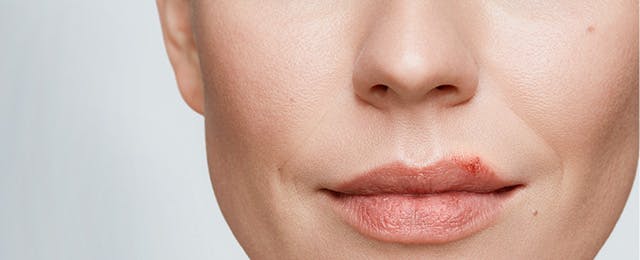WHAT ARE COLD SORES?
Cold sores are small, fluid-filled blisters that develop on the lips or around the mouth. They are unsightly but usually harmless, healing on their own within about ten days. Usually caused by the herpes simplex virus (HSV-1), cold sores are incredibly common. Nearly four billion people are infected with the virus globally. While some people experience recurring cold sores, others might never show any symptoms at all.
Keep reading to learn more about what cold sores are, what they look like, what you can do about them – and much more.
What are cold sores, exactly?
When people describe themselves as having a cold sore, they’re usually referring to a blister near or on their lip that’s caused by the herpes simplex virus 1 (HSV-1). Also called fever blisters, a cold sore is simply a symptom of the virus hijacking healthy cells.
What causes a cold sore?
HSV-1 is highly contagious, with an estimated 67 percent of the world population under the age of 50 infected. Once you are infected, the virus never leaves your body. Although most people aren’t exactly sure when they first encountered the virus, it’s usually contracted in early childhood, even if it did not manifest as a visible cold sore.
Once you have the virus, you may show no symptoms until the virus is ‘triggered’. At this point, the virus becomes more active and this is when you’ll suffer with cold sore outbreaks. Cold sore triggers include colds, flu and fever – hence the other common name for cold sores, fever blisters – as well as stress, fatigue, sunshine and wind.
Some people, however, may carry the virus without ever showing symptoms – in other words, they never have a cold sore – and so may pass the virus on to others unknowingly.
What does a cold sore look like?
A cold sore can start as a tingling, itching or burning sensation on your lip area. It may then develop into a small, inflamed red patch, where a blister-like top can form. This may break open and weep clear liquid, which then forms hard crusts. Once the crusts have dried out and fallen off, recovery is nearly complete. Once you’re completely healed, the area affected will return to normal.
COLD SORE STAGES
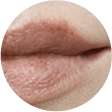
Stage 1
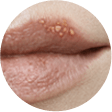
Stage 2
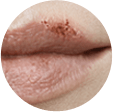
Stage 3
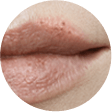
Stage 4
Where do you get cold sores?
Most people get cold sores on their lips, but it is possible to get cold sores on your nose, your eyes and your genitals, too.
Can you get a cold sore in your mouth?
Many people think they have a cold sore on their tongue or inside their mouth because canker sores can look a little like a cold sore blister on your lip. But canker sores only occur inside the moist areas of the mouth – on your gums, inner lips and tongue – while blisters caused by the herpes virus (aka cold sores) generally only appear on the outer edge of the lip or on the lip itself.
How do you get cold sores?
You can transmit and become infected by the HSV-1 virus by touching others, especially through kissing, as the virus is passed on through saliva and direct contact with the lips. You can also contract the virus by sharing infected items such as eating utensils or by sharing cosmetics. Remember that someone may be infected without showing symptoms.
Are cold sores contagious?
Yes, cold sores are extremely contagious. You can become infected with the virus through kissing, touching your fingers to your mouth or eyes (if your fingers have become infected with the virus from someone else, for example), and by sharing infected items. Although the virus doesn’t pass through the air, it has been shown to survive on hard surfaces.
Make sure you follow good hand-washing practices, washing with soap for at least 20 seconds and using hand sanitizer when needed. Avoiding close contact with those who have visible signs of the virus and not touching your mouth, eyes and nose are all ways you can help protect yourself against contracting the virus and passing it on to others.
How long do cold sores last?
In most cases, cold sores heal by themselves in about 8 to 10 days. However, you can reduce your recovery time significantly by using Abreva Cream at the first sign of a cold sore.
What are the steps to take when it comes to treating cold sores?
While cold sores are an unpleasant and potentially unsightly annoyance, they are unlikely to cause any lasting harm. Using a cold sore treatment such as Abreva Cream to minimize your recovery time not only makes it easier for you to go about your life as normal, it also helps reduce the time you are at your most contagious, with visible blisters. Apply as directed at the first sign to reduce your recovery period. And while you wait for your cold sore to heal fully, you can help hide it with these handy tips.
SOURCES:
- Herpex Simplex Virus. World Health Organization. https://www.who.int/news-room/fact-sheets/detail/herpes-simplex-virus. Accessed 11/13/2019.
- Herpex Simplex Virus. World Health Organization. https://www.who.int/news-room/fact-sheets/detail/herpes-simplex-virus. Accessed 11/13/2019.
- Cold Sore. Mayo Clinic. https://www.mayoclinic.org/diseases-conditions/cold-sore/symptoms-causes/syc-20371017. Accessed 11/13/2019.
- What’s the Difference Between Canker Sores and Cold Sores? Healthline. https://www.healthline.com/health/canker-sore-vs-cold-sore. Accessed 11/13/2019.
- Cold sore. Mayo Clinic. https://www.mayoclinic.org/diseases-conditions/cold-sore/symptoms-causes/syc-20371017. Accessed 11/13/2019.
- Cold sore. Mayo Clinic. https://www.mayoclinic.org/diseases-conditions/cold-sore/symptoms-causes/syc-20371017 Accessed 11/13/2019.


